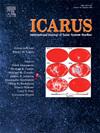测量坡度对火星熔岩流模拟的影响
IF 2.5
2区 物理与天体物理
Q2 ASTRONOMY & ASTROPHYSICS
引用次数: 0
摘要
最常用的模拟火星熔岩流的方法之一通常被称为“标准流变法”(SRA)。这种方法需要测量流动尺寸(例如,宽度、长度、厚度)和局部地形(例如,坡度),这些都用于粘度和屈服强度方程中。地形是大多数熔岩流模型的关键输入,需要详细分析输入的坡度值如何影响使用SRA的结果。在这里,我们提出了地形敏感性分析的SRA建模,使用最小,最大和一个标准差的测量斜率值。我们调查了16个熔岩流,14个在火星的阿尔西亚山以南,2个在北部。根据输入斜率的不同,粘度变化了5%到60%,屈服强度变化了5%到70%。这一粘度范围推断出16次流动中有8次的成分由玄武岩变为安山岩。我们还使用SRA测试了单个流,并从MOLA、HRSC和CTX数字高程模型(dem)中获得坡度。随着DEM分辨率的增加,从玄武岩到安山岩的成分也发生了同样的变化。这些结果强调了测试所有可能的坡度和使用最高分辨率地形数据集的重要性,以避免对流动成分的不准确解释。如果只有低至中等DEM数据集可用,则应谨慎解释结果。本文章由计算机程序翻译,如有差异,请以英文原文为准。
The effects of measured slope on Martian lava flow modeling
One of the most frequently used methods for modeling lava flows on Mars is commonly called the “standard rheologic approach” (SRA). This method requires measurements of the flow dimensions (e.g., width, length, thickness) and local topography (e.g., slope), which are used in equations of viscosity and yield strength, for example. Topography is a critical input for most lava flow models, a detailed analysis of how the input slope value affects the results using the SRA is needed. Here we present a topographic sensitivity analysis of SRA modeling, using the minimum, maximum, and one standard deviation of measured slope values. We investigated sixteen lava flows, fourteen south and two north of Arsia Mons, Mars. Depending on the input slope, a 5 % to 60 % change in viscosity, and a 5 % to 70 % change in yield strength was found. This viscosity range produced an inferred composition change from a basalt to an andesite for eight of the sixteen flows. We also tested a single flow using the SRA and derived slopes from MOLA, HRSC, and CTX digital elevation models (DEMs). The same compositional shift from a basalt to an andesite occurred with increasing DEM resolution. These results highlight the importance of testing the full range of possible slopes and using the highest resolution topographic dataset available to avoid inaccurate interpretation of flow composition. If only low to moderate DEM datasets are available, the results should be interpreted with caution.
求助全文
通过发布文献求助,成功后即可免费获取论文全文。
去求助
来源期刊

Icarus
地学天文-天文与天体物理
CiteScore
6.30
自引率
18.80%
发文量
356
审稿时长
2-4 weeks
期刊介绍:
Icarus is devoted to the publication of original contributions in the field of Solar System studies. Manuscripts reporting the results of new research - observational, experimental, or theoretical - concerning the astronomy, geology, meteorology, physics, chemistry, biology, and other scientific aspects of our Solar System or extrasolar systems are welcome. The journal generally does not publish papers devoted exclusively to the Sun, the Earth, celestial mechanics, meteoritics, or astrophysics. Icarus does not publish papers that provide "improved" versions of Bode''s law, or other numerical relations, without a sound physical basis. Icarus does not publish meeting announcements or general notices. Reviews, historical papers, and manuscripts describing spacecraft instrumentation may be considered, but only with prior approval of the editor. An entire issue of the journal is occasionally devoted to a single subject, usually arising from a conference on the same topic. The language of publication is English. American or British usage is accepted, but not a mixture of these.
 求助内容:
求助内容: 应助结果提醒方式:
应助结果提醒方式:


